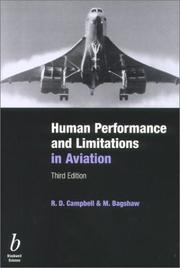Book
ISBN: 1622735552 9781622735556 9781622734429 1622734424 Year: 2019 Publisher: Wilmington, DE Vernon Press
Abstract | Keywords | Export | Availability | Bookmark
 Loading...
Loading...Choose an application
- Reference Manager
- EndNote
- RefWorks (Direct export to RefWorks)
Book
Year: 1980 Publisher: Washington Outdoor Recreation Resources Review Commission
Abstract | Keywords | Export | Availability | Bookmark
 Loading...
Loading...Choose an application
- Reference Manager
- EndNote
- RefWorks (Direct export to RefWorks)

ISBN: 0632059656 9780632059652 Year: 2002 Publisher: Oxford Malden, MA Ames, Iowa Blackwell Science [US distributor] Iowa State University Press
Abstract | Keywords | Export | Availability | Bookmark
 Loading...
Loading...Choose an application
- Reference Manager
- EndNote
- RefWorks (Direct export to RefWorks)
"Human error is cited as a major cause in over 70% of accidents, and it is widely agreed that a better understanding of human capabilities and limitations - both physical and psychological - would help reduce human error and improve flight safety. This book was first published when the UK Civil Aviation Authority introduced an examination in human performance and limitations for all private and professional pilot licences. Now the Joint Aviation Authorities of Europe have published a new syllabus as part of their Joint Aviation Requirements for Flight Crew Licensing. The book has been completely revised and rewritten to take account of the new syllabus. The coverage of basic aviation psychology has been greatly expanded, and the section on aviation physiology now includes topics on the high altitude environment and on health maintenance."--Publisher's description.
Book
ISBN: 3846762865 Year: 2017 Publisher: Paderborn : Brill,
Abstract | Keywords | Export | Availability | Bookmark
 Loading...
Loading...Choose an application
- Reference Manager
- EndNote
- RefWorks (Direct export to RefWorks)
Design als Innovationsgenerator: Die nächste industrielle Revolution beginnt ... genau jetzt. Warten Sie nicht länger auf den nächsten heißen Trend, dem Sie folgen können. Entwickeln Sie selbst Innovationen, die diesen Namen verdienen!Human Centered Design versteht sich als Verbindung aus kreativer Gestaltung, humanwissenschaftlicher Fundierung und experimentellem Arbeiten - und öffnet sich dabei bewusst einem interdisziplinären Blickwinkel. Martin Ludwig Hofmann führt in die Methodik des Human Centered Design ein und erläutert die Haltung, die diesem erweiterten Designverständnis zugrunde liegt. Eine intellektuelle Tour de Force von Apple über Adorno, von Naoto Fukasawa über Michel Foucault, von Paul Virilio bis zum kalifornischen Designbüro IDEO. Was Gestalter tun, ist in einem hohen Maße gesellschaftlich relevant. Es wird Zeit, dass wir uns dessen bewusst werden.
Design --- Philosophy. --- Human factors.
Book
Year: 2019 Publisher: Los Alamitos, CA : IEEE Computer Society,
Abstract | Keywords | Export | Availability | Bookmark
 Loading...
Loading...Choose an application
- Reference Manager
- EndNote
- RefWorks (Direct export to RefWorks)
Book
ISBN: 3764001550 Year: 1981 Publisher: Düsseldorf Beton-Verlag
Abstract | Keywords | Export | Availability | Bookmark
 Loading...
Loading...Choose an application
- Reference Manager
- EndNote
- RefWorks (Direct export to RefWorks)
Book
Year: 2003 Publisher: Washington, D.C. : U.S. Dept. of Transportation, Federal Aviation Administration, Office of Aerospace Medicine,
Abstract | Keywords | Export | Availability | Bookmark
 Loading...
Loading...Choose an application
- Reference Manager
- EndNote
- RefWorks (Direct export to RefWorks)
Book
Year: 1980 Publisher: Gaithersburg, MD : U.S. Dept. of Commerce, National Institute of Standards and Technology,
Abstract | Keywords | Export | Availability | Bookmark
 Loading...
Loading...Choose an application
- Reference Manager
- EndNote
- RefWorks (Direct export to RefWorks)
Book
ISBN: 9798350326871 Year: 2023 Publisher: Piscataway : IEEE,
Abstract | Keywords | Export | Availability | Bookmark
 Loading...
Loading...Choose an application
- Reference Manager
- EndNote
- RefWorks (Direct export to RefWorks)
Book
ISBN: 1003195075 1003195075 1000828425 Year: 2023 Publisher: London, England ; New York, New York : Routledge,
Abstract | Keywords | Export | Availability | Bookmark
 Loading...
Loading...Choose an application
- Reference Manager
- EndNote
- RefWorks (Direct export to RefWorks)
This book is about perception, emotion, and affect in architecture: how and why we feel the way that we do and the ways in which our surroundings and bodies contribute to this. Our experience of architecture is an embodied one, with all our senses acting in concert as we move through time and space. The book picks up where much of the critique of architectural aestheticism at the end of the twentieth century left off: illustrating the limitations and potential consequences of attending to architecture as the visually biased practice which has steadily become the status quo within both industry and education. It draws upon interdisciplinary research to elucidate the reasons why this is counter-productive to the creation of meaningful places and to articulate the embodied richness of our touching encounters. A "felt-phenomenology" is introduced as a more-than visual alternative capable of sustaining our physical, emotional, and psychological well-being. By recognising the reciprocal and participatory relationship that exists between atmospheric affect and our (phenomenological) bodies, we begin to appreciate the manifold ways in which we touch, and are touched, by our built environment. As such, Touching Architecture will appeal to those with an interest in architectural history and theory as well as those interested in the topic of atmospheres, affect, and embodied perception.

 Search
Search Feedback
Feedback About UniCat
About UniCat  Help
Help News
News